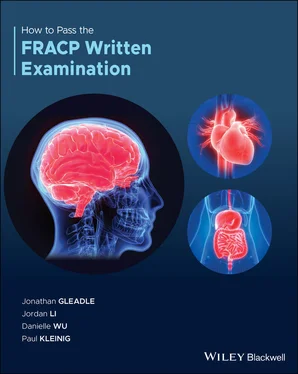After biochemical diagnosis of acromegaly, imaging studies are needed; a MRI scan of the head is the preferred modality and should be obtained to determine tumour size, location, and invasiveness. Visual field testing is performed if the tumour is touching or compressing the optic chiasm. A thorough ophthalmologic examination should be performed if the patient describes diplopia and the tumour is invading the cavernous sinus. Further endocrine testing is also necessary to determine general pituitary function and need for hormone replacement therapy.
Acromegaly is associated with diabetes, hypertension, OSA, and cardiovascular disease. There is also increased risk for colonic polyps and colonoscopy is indicated when acromegaly is diagnosed. Excess GH is also associated with an increase in thyroid nodules and thyroid cancer. A thyroid ultrasound may be performed if there is palpable thyroid nodularity.
The goals of therapy for acromegaly are to normalise GH and IGF‐1 activity, reduce tumour size, prevent local mass effects, reduce signs and symptoms of disease, prevent or improve medical comorbidities, and prevent premature mortality. Surgery is the treatment of choice. Surgery is useful to debulk or resect the somatotroph adenoma, decompress local mass effects, and rapidly lower or normalise GH and IGF‐1 values.
Surgery is recommended for all patients with microadenomas, and in experienced hands >85% are curable. Surgery is also recommended for all patients with macroadenomas and mass effects. Surgical cure rates for macroadenomas range from 40–50%, likely reflecting the high prevalence of extrasellar extension and parasellar invasion of the cavernous sinus. The transsphenoidal approach is the most common procedure, with craniotomy reserved for select cases involving large, extrasellar lesions. Transnasal endoscopic endonasal procedures offer improved visibility and are rapidly replacing microscopic transsphenoidal techniques.
Medical therapy is largely used in an adjuvant role for patients with residual disease following surgery. However, primary medical therapy may be considered in subjects with macroadenomas and extrasellar involvement (especially involving the cavernous sinus) but no evidence of local mass effects such as chiasmal compression. In this situation, surgery will unlikely be curative and primary medical therapy in lieu of surgery may be considered. Primary medical therapy may also be considered in patients, who are at high risk from surgery and according to patient preferences. In a patient who is undergoing primary medical therapy, surgery can always be reconsidered for tumour debulking to improve response to medical therapy. Somatostatin receptor ligands (SRLs) such as octreotide are the mainstay of medical treatment. Octreotide acts primarily on somatostatin receptor subtypes II and V, inhibiting GH secretion. Dopamine agonist such as cabergoline can also be used. Cabergoline monotherapy results in biochemical control rates of approximately 35%; similar benefits have also been seen with the addition of cabergoline to an SRL in patients with inadequate control on SRL therapy. GH receptor antagonist, pegvisomant monotherapy administered as second‐line therapy yields biochemical control rates of 90% or more in clinical trials and closer to 60% in real‐world surveillance studies. Radiation therapy is largely relegated to an adjuvant role.

Melmed, S., Bronstein, M., Chanson, P., Klibanski, A., Casanueva, F., Wass, J., Strasburger, C., Luger, A., Clemmons, D. and Giustina, A. (2018). A Consensus Statement on acromegaly therapeutic outcomes. Nature Reviews Endocrinology, 14(9), pp.552–561.
https://www.nature.com/articles/s41574-018-0058-5
2. Answer: C
The patient is likely to have a diagnosis of adrenal crisis with symptoms of nausea, vomiting, hypotension, severe lethargy, weakness, altered mental state, hyponatraemia, hyperkalaemia, and a known history of adrenal insufficiency. Her low BP suggests that she has adrenal crisis with haemodynamic instability, rather than adrenal insufficiency. Septic shock can clinically mimic adrenal insufficiency with symptoms of hypotension, fever, and gastrointestinal symptoms, thus it is important not to miss either the diagnosis of sepsis or adrenal crisis and initiate appropriate investigations and treatment. Administration of appropriate dosage of corticosteroids is imperative to avoid adverse sequalae.
In patients with vomiting and diarrhoea, administration of 100 mg IV hydrocortisone initially is recommended followed by IV hydrocortisone 100 mg qid then 50 mg qid the next day until it is safe to change to oral hydrocortisone after 24 hours. Oral hydrocortisone is usually prescribed at 2 to 3 times the normal oral hydrocortisone dose, with a gradual taper back to the patient's regular dose over the following 2 to 3 days. Administration of oral fludrocortisone is not required if the initial hydrocortisone doses exceed 50 mg over 24 hours for patients with primary adrenal insufficiency as high doses of hydrocortisone will exert mineralocorticoid activity. Oral fludrocortisone can be resumed once the patient is able to have oral hydrocortisone.
Biochemical abnormalities observed in patients with adrenal crisis include hyponatraemia, hyperkalaemia, hypercalcaemia, hypoglycaemia, neutropenia, lymphocytosis, eosinophilia, and mild normocytic anaemia. IV fluid resuscitation with 0.9% normal saline 1L within the first hour is recommended. If the patient is hypoglycaemic, intravenous dextrose 5% in normal saline is given.
It is important for patients with a medical history of adrenal insufficiency and adrenal crisis to have a sick day plan and ongoing education about the condition. Without appropriate recognition and treatment of adrenal crisis, patients may potentially take longer to diagnose, leading to poorer outcomes. MedicAlert bracelets, necklaces, easy access to intramuscular hydrocortisone, oral corticosteroid medications, ambulance services and hospitals are important measures to prevent subsequent adrenal crisis in patients with past history of adrenal crisis or insufficiency.

Rushworth R, Torpy D, Falhammar H. Adrenal Crisis. New England Journal of Medicine. 2019;381(9):852–861.
https://www.nejm.org/doi/full/10.1056/NEJMra1807486?url_ver=Z39.88-2003&rfr_id=ori:rid:crossref.org&rfr_dat=cr_pub%3dpubmed
3. Answer: D
An ‘adrenal incidentaloma’ is an adrenal mass, greater than 1 cm in diameter, that is found serendipitously when a patient undergoes a radiological examination for reasons unrelated to adrenal disease. There has been an increased incidence of ‘adrenal incidentalomas’ due to the widespread use of CT and MRI. The prevalence of adrenal incidentalomas during autopsies ranges from 1 to 9% and increases with increasing age.
Most adrenal tumours are non‐hypersecreting, benign adrenocortical adenomas. Adrenal masses, such as cortisol‐secreting adrenocortical adenoma, unilateral or bilateral congenital adrenal hyperplasia, pheochromocytoma, adrenocortical carcinoma, and metastatic carcinoma, are also frequently described. Metastases to the adrenal glands are usually bilateral; primary malignancies that are commonly associated with adrenal metastasis include carcinoma of the lung, kidney, colon, breast, oesophagus, pancreas, liver, and stomach.
Focused history taking and clinical examination is important to rule out functioning and malignant adrenal tumours to diagnose the underlying medical conditions, e.g. Cushing's syndrome, pheochromocytoma, primary aldosteronism, adrenocortical carcinoma, and metastatic cancer.
Читать дальше














